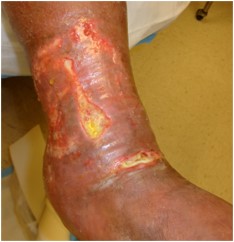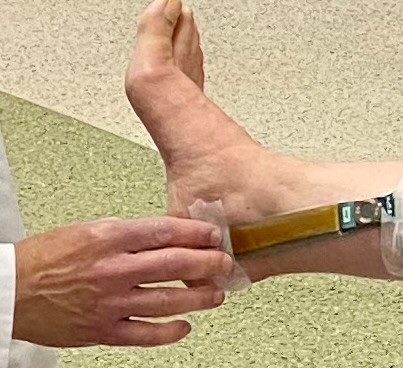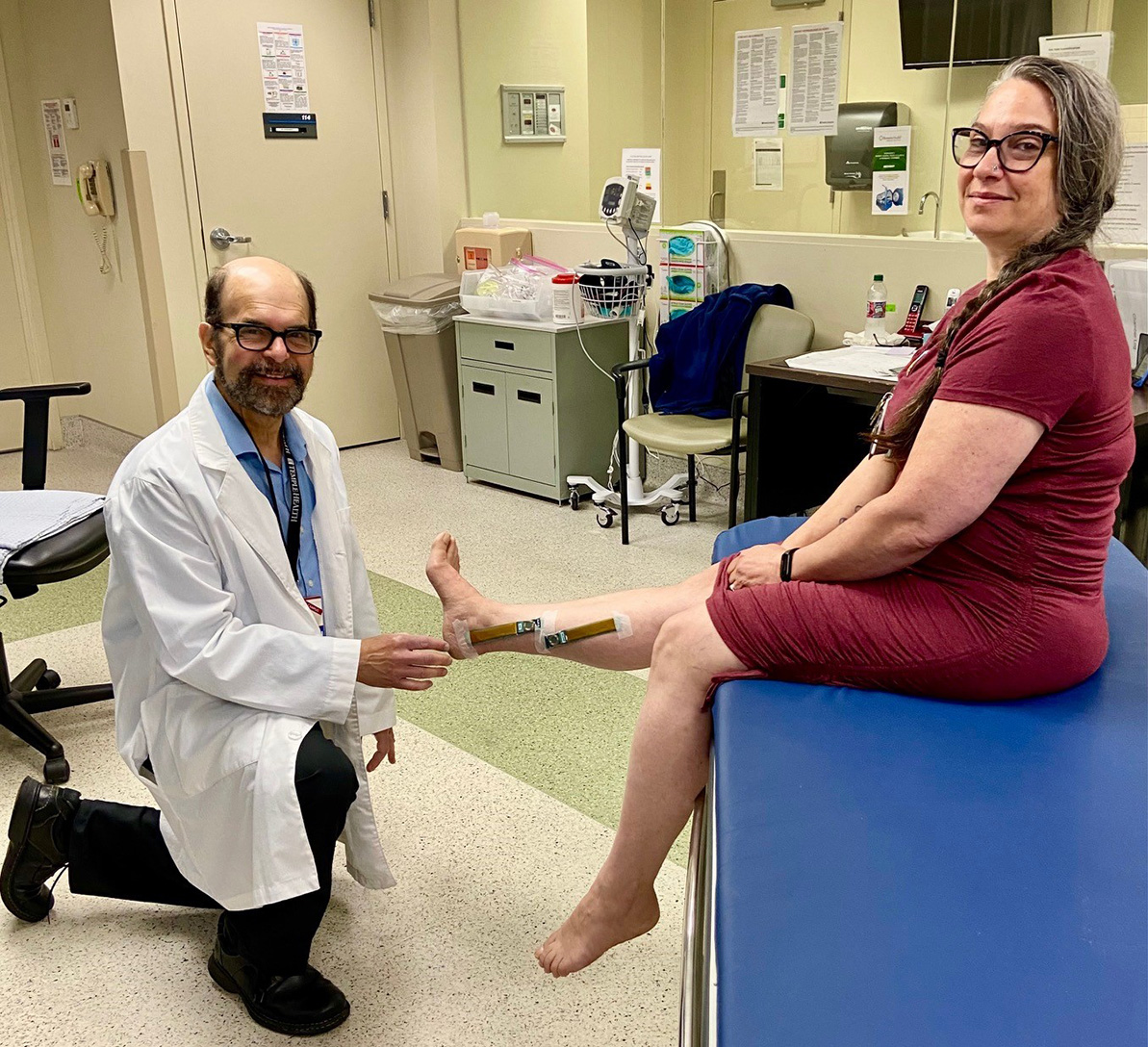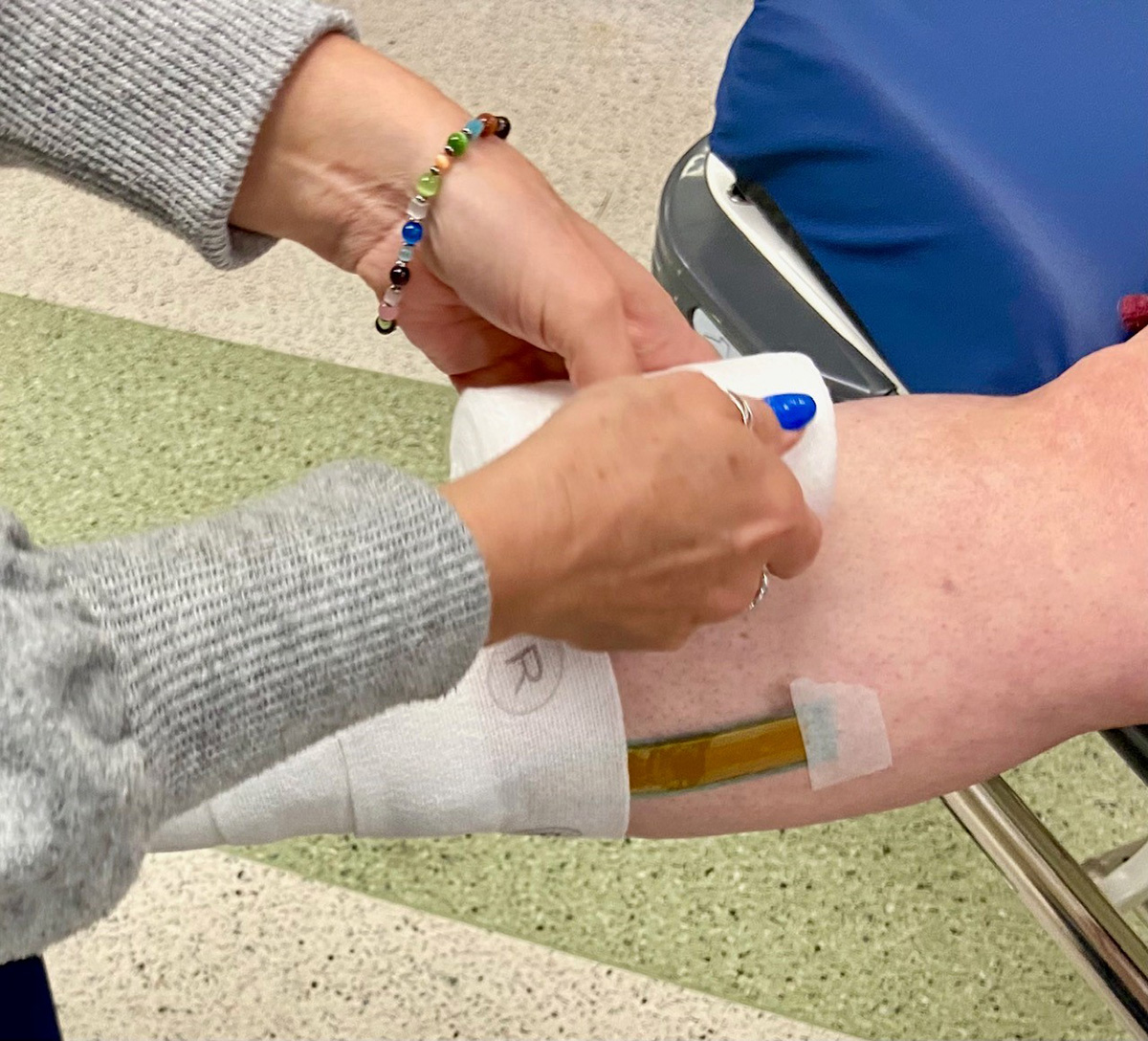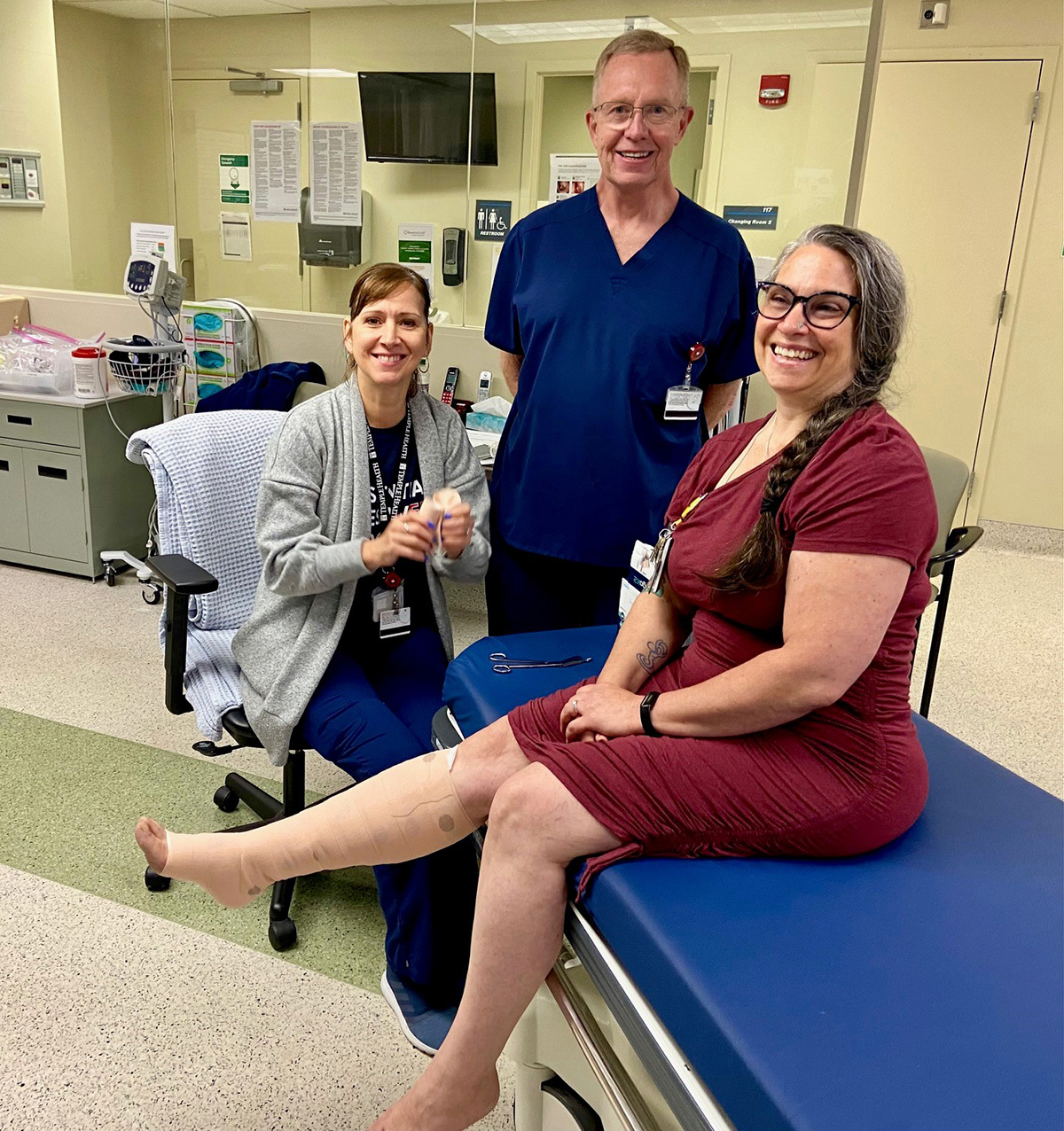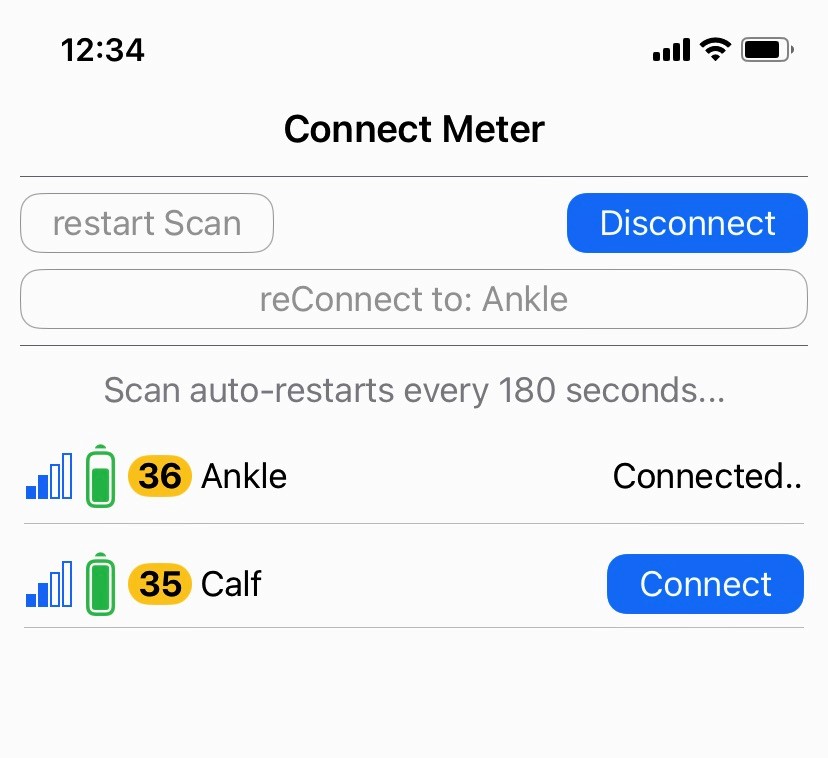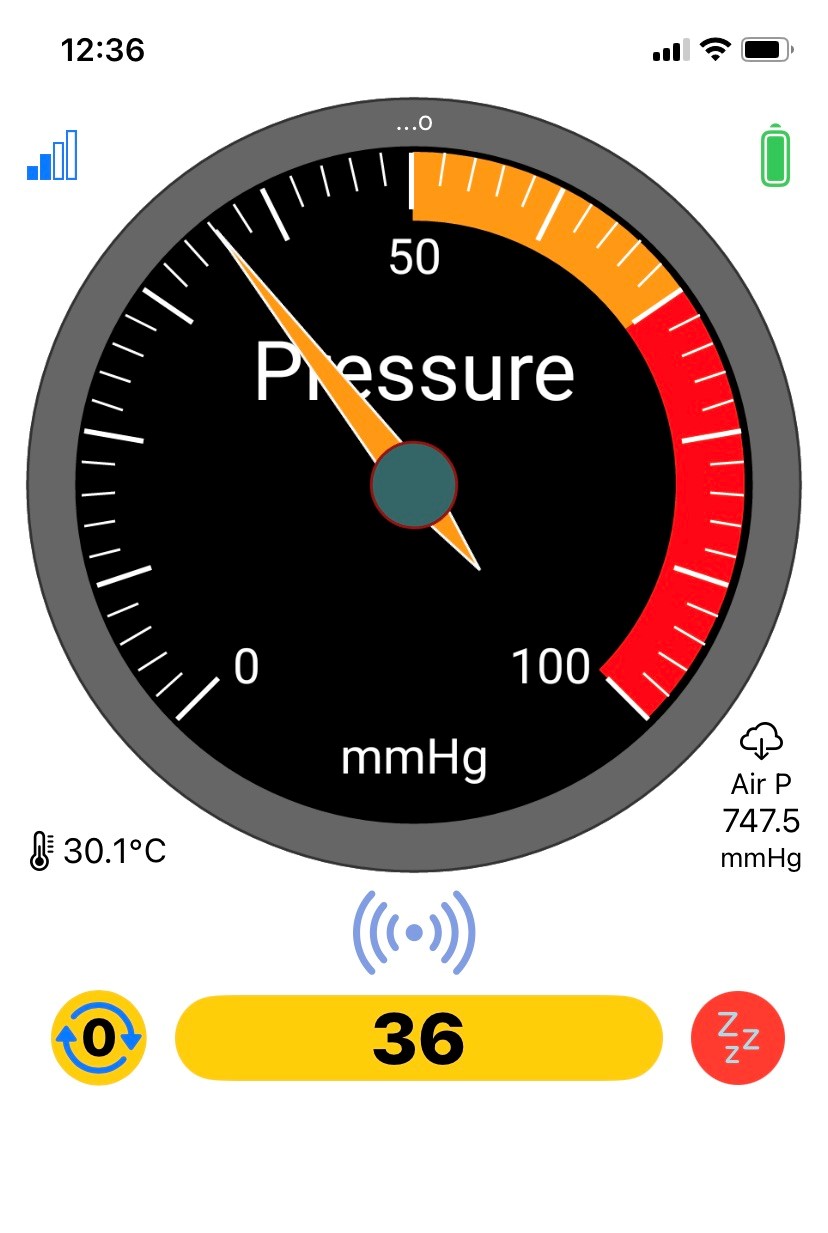Anyone who is experienced in the field of wound care knows that compression when properly applied for a patient with edema can have darn near miraculous results – regardless of whether the wound was a venous leg ulcer. However, we can also hurt people. I know this small photo is poor quality, but I keep it around to remind me what can happen when we are not careful. It is a patient who was treated with a high stretch wrap for his edema — without first undergoing arterial testing– and as a result, developed multiple ischemic wounds. We need to make sure that anyone who applies compression is properly trained, and the only way to do that is to actually measure the compression applied!
When Dr. Goldman showed me the device he had developed, I thought it was brilliant and I wanted to share it with everyone!
–Caroline
Transformational ideas in wound healing and lymphedema: Compression dressings – unwrapped!
Robert Goldman, MD, MS, ABPMR, ABPM-UHM
Ever wonder how much pressure your dressings apply on the leg? I’m aware that a lot of people would answer that the answer is on the package label, but in fact, the only way to be sure how much pressure you have applied is to measure it. Most people will be thinking to themselves, “How hard could that be? Surely someone has already figured this out!” However, the compression pressure delivered by any particular system depends on many factors – how tight the dressing, how much the overlap, the circumference of the leg, and many others. Since the compression pressure delivered by a wrap is a major factor that determines edema control and thus healing, and since so many factors can affect it, we ought to be able to measure it. I should also add that knowing how much compression we have provided can also keep us from hurting patients by providing too much compression.
Why did we develop this?
I’m a board-certified Physical Medicine and Rehabilitation (PM&R) physician for 30 years, with 25 years of experience in wound healing, including a Fellowship in Wound Research at University of Pennsylvania. I am currently a practicing wound care and hyperbaric physician affiliated with Temple Health in Philadelphia. I also have an MS in Biomedical Engineering from Drexel. While a resident I noted the importance of pressure measurement in rehabilitation. This led to the first of about a dozen patients I authored in wearable pressure measurement. Much of this was self-funded. The most recent patent (2021) lead to a partner-capitalized company WearSense, which developed a wearable pressure measuring device for lymphedema and wound healing.
What did we develop?
We developed a small, lightweight, wearable pressure sensor that fits within wraps or garments and measures the compression pressure. Each sensor is about half the size of a pack of matches and is attached to a sensor about the size and flexibility of a stick of chewing gum. The battery lasts 1-2 months and it is Bluetooth enabled to transmit data to an iPhone. An app on the iPhone displays pressure digitally and on an old-school pressure gauge, as pictured. The app can follow a dozen sensors simultaneously. See Log in – Metso (wearsense.com) for further details.
How do we know it measures what we say it does?
The WearSenseTM sensor is calibrated by comparing it to a “gold standard” – the Picopress® pressure sensor. One verifies accuracy by comparing measurements on a series of garments and stockings. The accuracy of the wearable sensor is <+/- 20% for 10-20 mm Hg, and <+/- 15% above 20 mm Hg.
How are we testing it?
To be clear, we are not using this device on patients. Right now, we are using it only to help train clinicians to be better and more consistent at applying compression bandages or garments. To do that, I started working with my friend and colleague Frank Aviles PT, CWS, CLT-LANA, AWCA who is a nationally recognized wound care and lymphedema practitioner. Frank teaches compression around the country, and both of us wanted to have a way to determine how a clinician is performing when a wrap is applied.
That lead to our giving a series of “Wrapping Parties” which in a fun way teach staff how to optimize their wrapping technique and achieve the correct bandage pressure. So far, we have worked with about 15 staff members. We did a Wrapping Party at the Temple Health Episcopal campus Advanced Wound Center, which suggested that the most uniform compression was achieved with a specific product which had a visual guide of ovals-turning-to-circles, when compared to a long stretch dressing with foam backing.
Frank Aviles, working from his center outside Atlanta, has tested several types of hook and loop closures, multilayer wraps, and compression with visual guides. Members of his wrapping party were physicians, fitters, salespeople, and lymphedema therapists. We also have one wrapping party planned for a local Podiatry School.
What is our short-term goal?
Remember that we are developing this on our own. It costs money to build these sensors, and I can’t sell them for use on patients yet, but I can make them available to clinicians who want to use them to help with training their staff. If you are interested in obtaining one, email me at robert@wear-sense.com.
What are our plans for the device?
We are a startup with a transformational product for wound healing and rehabilitation. We are interested in seed capital for the next stage of growth. Specifically, we are looking for money for devices for staff training as a bridge to FDA registration and industry license. The wearable sensor market is growing rapidly! The need for this device is growing daily as more and more patients develop lower extremity edema and ulcers.
I’d like to thank the folks at the Temple Health Episcopal Advanced Wound Center who participated in our “wrapping party”:
- Stacy Dickel, LPN
- Kenneth Fitzgerald, RN
- Jennifer Parilo RN, BSN, CWOCN.
- Ruthann Rosado, LPN
- Robert Goldman, MD
Image Gallery
(Click images to enlarge & read captions)
Please note, there is no relationship expressed or implied between WearSense LLC and Temple Health System. The opinions expressed in this article are those of Robert Goldman, MD and not WearSense. Dr. Goldman has no financial relationship with any dressing manufacturer. Photos are the property of Robert Goldman, MD and are not to be used without his permission.

Dr. Fife is a world renowned wound care physician dedicated to improving patient outcomes through quality driven care. Please visit my blog at CarolineFifeMD.com and my Youtube channel at https://www.youtube.com/c/carolinefifemd/videos
The opinions, comments, and content expressed or implied in my statements are solely my own and do not necessarily reflect the position or views of Intellicure or any of the boards on which I serve.


